HTML
--> --> -->In the process
The heavy quark structure functions obtained in DIS at HERA, from the measurement of the inclusive heavy quark cross-sections, are an important test of QCD. These structure functions are obtained after applying small corrections to the heavy-quark longitudinal structure functions [1-5]. The heavy quark cross-section is defined in terms of the heavy quark structure functions as
$ \frac{{\rm d}^{2}\sigma^{{\cal{Q}}\overline{{\cal{Q}}}}}{{\rm d}x{\rm d}Q^{2}} = \frac{2{\pi}\alpha^{2}(Q^{2})}{xQ^{4}}\{[1+(1-y)^{2}]F_{2}^{{\cal{Q}}\overline{{\cal{Q}}}}(x,Q^{2}) -y^{2}F_{L}^{{\cal{Q}}\overline{{\cal{Q}}}}(x,Q^{2}) \}, $  | (1) |
$ \begin{aligned}[b] \sigma^{{\cal{Q}}\overline{{\cal{Q}}}}_{\mathrm{red}} =& \frac{{\rm d}^{2}\sigma^{{\cal{Q}}\overline{{\cal{Q}}}}}{{\rm d}x{\rm d}Q^{2}} \cdot \frac{xQ^{4}}{2{\pi}\alpha^{2}(Q^{2})(1+(1-y)^{2})}\\ =& F_{2}^{{\cal{Q}}\overline{{\cal{Q}}}}(x,Q^{2})-f(y)F_{L}^{{\cal{Q}}\overline{{\cal{Q}}}}(x,Q^{2}), \end{aligned} $  | (2) |
$ F_{2}^{{\cal{Q}}\overline{{\cal{Q}}}}(x,Q^{2}) = \frac{{\rm d}^{2}\sigma^{\mathrm{jet}}_{{\cal{Q}}}/{{\rm d}x{\rm d}Q^{2}}} {{\rm d}^{2}\sigma^{\mathrm{had,NLO}}_{{\cal{Q}}}/{{\rm d}x{\rm d}Q^{2}}} F_{2}^{{\cal{Q}}\overline{{\cal{Q}}},\mathrm{NLO}}(x,Q^{2}). $  | (3) |
$ \begin{array}{l} \sigma^{{\cal{Q}}\overline{{\cal{Q}}}}_{\mathrm{red}} = F_{2}^{{\cal{Q}}\overline{{\cal{Q}}}}(x,Q^{2})[1-f(y)F_{L}^{{\cal{Q}}\overline{{\cal{Q}}}}(x,Q^{2})/F_{2}^{{\cal{Q}}\overline{{\cal{Q}}}}(x,Q^{2})] .\end{array} $  | (4) |
  |   |   |   |   |   |
  | 60 | 7 |   | 111 | 1.0 |
  | 60 | 7 |   | 77 | 1.0 |
Table1.Kinematic coverage of simulated heavy quark structure functions used in LHeC studies, showing the number of pseudo-data points,
This paper is organized as follows. In Sect. II, we give a summary of the ratio of heavy quark structure functions. Then we introduce a method to calculate the ratio
$ \begin{aligned}[b] q^{s}(x,n_{f},\mu^{2}) =& \sum\limits_{l = 1}^{n_{f}}[f_{l}(x,n_{f},\mu^{2})+\overline{f}_{l}(x,n_{f},\mu^{2})],\\ g(x,n_{f},\mu^{2}) =& f_{g}(x,n_{f},\mu^{2}), \end{aligned} $  | (5) |
$ F^{\rm ZMVFN}_{k,{\cal{Q}}} = \sum\limits_{j = 0}^{\infty}a_{s}^{j}(n_{f}+1)\sum\limits_{i = q,g,{\cal{Q}}} C_{k,i}^{(j)}(n_{f}+1){\otimes}f_{i}(n_{f}+1) $  | (6) |
$ F^{\rm FFNS} _{k,{\cal{Q}}} = \sum\limits_{j = 0}^{\infty}a_{s}^{j}(n_{f})\sum\limits_{i = q,g} H_{k,i}^{(j)}(n_{f}){\otimes}f_{i}(n_{f}), $  | (7) |
$ \chi = x\left(1+\frac{4m_{{\cal{Q}}}^{2}}{Q^{2}}\right), $  | (8) |
Within this scheme, heavy quark densities arise via the
$ \begin{aligned}[b] F_{2}^{{\cal{Q}}\overline{{\cal{Q}}}}(x,Q^{2}) =& C_{2,g}^{{\cal{Q}}\overline{{\cal{Q}}}}(x,\xi){\otimes}G(x,\mu^{2}),\\ F_{L}^{{\cal{Q}}\overline{{\cal{Q}}}}(x,Q^{2}) =& C_{L,g}^{{\cal{Q}}\overline{{\cal{Q}}}}(x,\xi){\otimes}G(x,\mu^{2}), \end{aligned} $  | (9) |
$ \begin{array}{l} C_{k,g}(z,\xi) = C^{0}_{k,g}(z,\xi)+a_{s}(\mu^{2})C^{1}_{k,g}(z,\xi). \end{array} $  | (10) |
$ x_{g}^{{\cal{Q}}} = \frac{Q^{2}+M^{2}_{t}}{W^{2}+Q^{2}} = x_{bj}\left(1+\frac{M^{2}_{t}}{Q^{2}}\right), $  | (11) |
$ \begin{array}{l} G(x,Q^{2})_{x{\rightarrow}0} = f_{g}(Q^{2})x^{-\lambda_{g}(Q^{2})}. \end{array} $  | (12) |
$ \begin{array}{l} F_{2}^{c(b)} = f_{{\cal{Q}}}(Q^{2})x^{-\lambda_{\rm eff}}. \end{array} $  | (13) |
Within the dipole formulation of the
In recent years [63-77], various successful phenomenological methods have examined charm and beauty structure functions. This importance, along with the t-quark density, can be explored at future circular collider energies. One of the important top quark production modes is
$ \frac{F_{L}^{{\cal{Q}}\overline{{\cal{Q}}}}}{F_{2}^{{\cal{Q}}\overline{{\cal{Q}}}}} = \frac{C_{L,g}^{Q\overline{Q}}(x,\xi){\odot}x^{\lambda_{g}}}{C_{2,g}^{Q\overline{Q}}(x,\xi){\odot}x^{\lambda_{g}}}, $  | (14) |
$ \begin{aligned}[b] \frac{\partial}{\partial{\ln}\frac{1}{x}}{\ln}\frac{F_{L}^{{\cal{Q}}\overline{{\cal{Q}}}}(x,Q^{2})}{F_{2}^{{\cal{Q}}\overline{{\cal{Q}}}}(x,Q^{2})} =& \lambda_{L}^{{\cal{Q}}\overline{{\cal{Q}}}}-\lambda_{2}^{{\cal{Q}}\overline{{\cal{Q}}}}\\ =& \frac{\partial}{\partial{\ln}\frac{1}{x}}{\ln}\frac{C_{L,g}^{{\cal{Q}}\overline{{\cal{Q}}}} (x,\xi){\odot}x^{\lambda_{g}}}{C_{2,g}^{{\cal{Q}}\overline{{\cal{Q}}}}(x,\xi){\odot}x^{\lambda_{g}}}. \end{aligned} $  | (15) |
$ \begin{aligned}[b] \lambda_{L}^{{\cal{Q}}\overline{{\cal{Q}}}} =& {\partial \ln F_{L}^{{\cal{Q}}\overline{{\cal{Q}}}}(x,Q^{2})}/{\partial \ln(1/x)},\\ \lambda_{2}^{{\cal{Q}}\overline{{\cal{Q}}}} =& {\partial \ln F_{2}^{{\cal{Q}}\overline{{\cal{Q}}}}(x,Q^{2})}/{\partial \ln(1/x)}. \end{aligned} $  | (16) |
HERA data are expressed in terms of two variables,
$ \begin{aligned}[b] F_{L}^{{\cal{Q}}\overline{{\cal{Q}}}}(x,Q^{2}) =& F_{L}^{{\cal{Q}}\overline{{\cal{Q}}}}\left(W^{2} = \frac{x}{Q^{2}},Q^{2}\right),\\ F_{2}^{{\cal{Q}}\overline{{\cal{Q}}}}(x,Q^{2}) =& F_{2}^{{\cal{Q}}\overline{{\cal{Q}}}}\left(W^{2} = \frac{x}{Q^{2}},Q^{2}\right). \end{aligned} $  | (17) |
$ \begin{aligned}[b] F_{L}^{{\cal{Q}}\overline{{\cal{Q}}}}(W^{2}){ \sim} (W^{2})^{\lambda_{L}},\quad F_{2}^{{\cal{Q}}\overline{{\cal{Q}}}}(W^{2}){ \sim} (W^{2})^{\lambda_{2}}. \end{aligned} $  | (18) |
$ \begin{aligned}[b]& \lambda_{L}^{{\cal{Q}}\overline{{\cal{Q}}}} = \frac{\partial \ln F_{L}^{{\cal{Q}}\overline{{\cal{Q}}}}(W^{2})}{\partial \ln W^{2}},\\ &\lambda_{2}^{{\cal{Q}}\overline{{\cal{Q}}}} = \frac{\partial \ln F_{2}^{{\cal{Q}}\overline{{\cal{Q}}}}(W^{2})}{\partial \ln W^{2}}. \end{aligned} $  | (19) |
$ {\Rightarrow}\; {\Delta}\lambda_{L2}^{{\cal{Q}}\overline{{\cal{Q}}}} = \lambda_{L}^{{\cal{Q}}\overline{{\cal{Q}}}}- \lambda_{2}^{{\cal{Q}}\overline{{\cal{Q}}}} = \frac{\partial }{\partial \ln W^{2}}\ln \frac{F_{L}^{{\cal{Q}}\overline{{\cal{Q}}}}(W^{2})}{F_{2}^{{\cal{Q}}\overline{{\cal{Q}}}}(W^{2})}. $  | (20) |
A.Charm and beauty
In Refs. [1] and [2], the reduced cross-sections and structure functions of the charm and beauty quarks at center-of-mass energies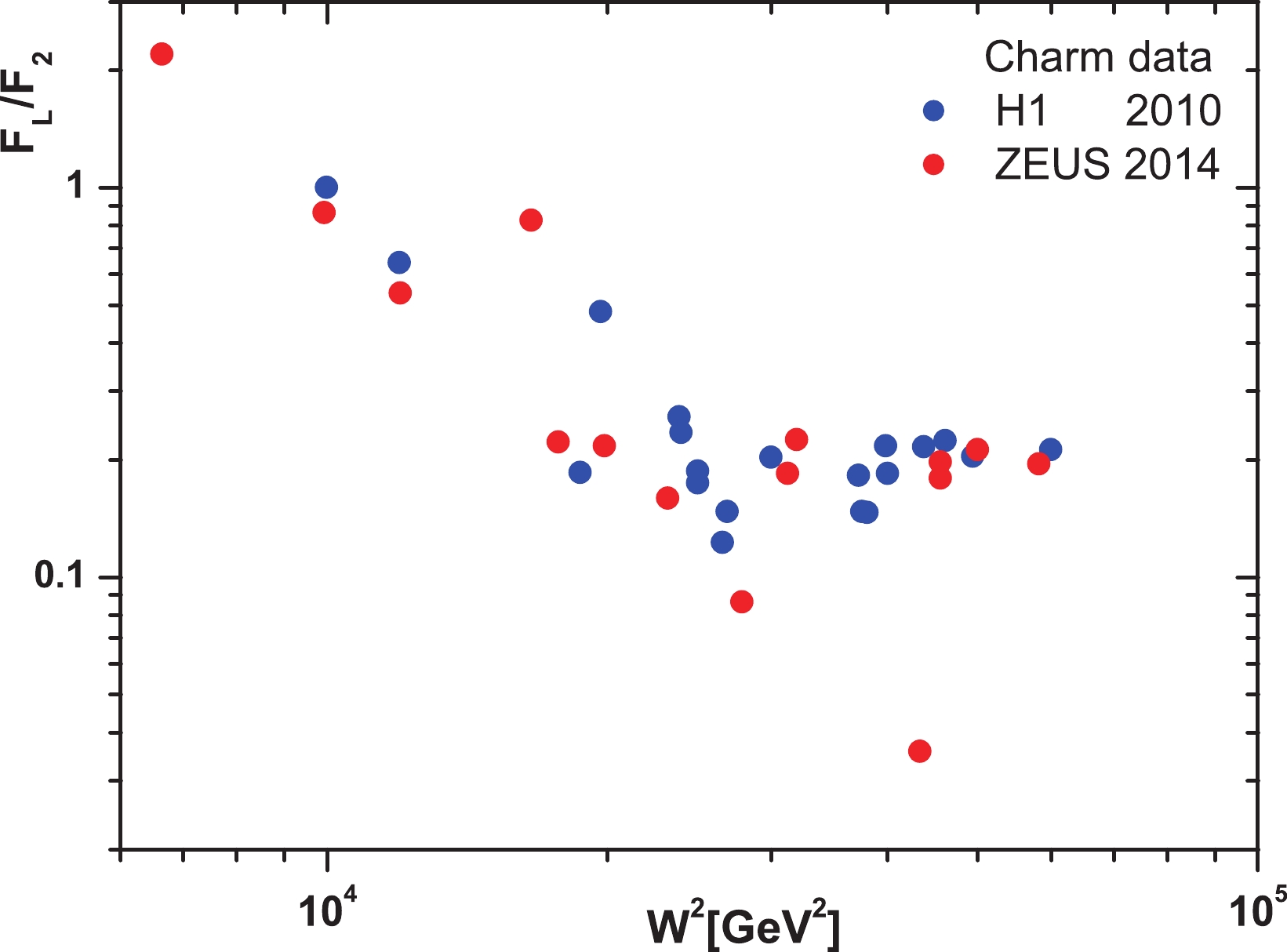 Figure1. (color online) Ratio of charm structure functions, with respect to HERA data (H1 2010 [1] and ZEUS 2014 [2]), shown as a function of
Figure1. (color online) Ratio of charm structure functions, with respect to HERA data (H1 2010 [1] and ZEUS 2014 [2]), shown as a function of 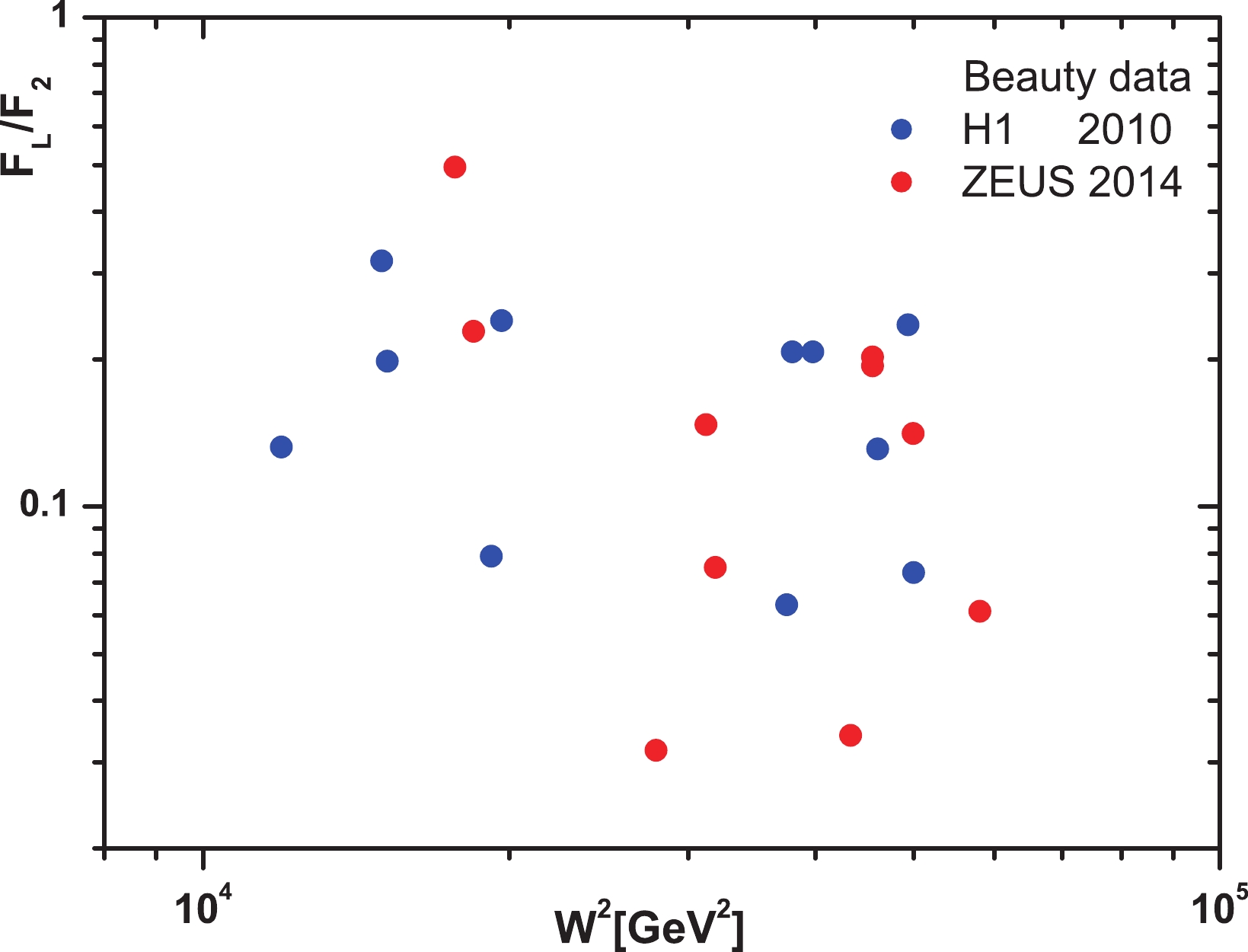 Figure2. (color online) Ratio of beauty structure functions, with respect to HERA data (H1 2010 [1] and ZEUS 2014 [2]), shown as a function of
Figure2. (color online) Ratio of beauty structure functions, with respect to HERA data (H1 2010 [1] and ZEUS 2014 [2]), shown as a function of   |   | Coll. Data |
  |   | Ref. [1] |
  |   | Ref. [2] |
  |   | Ref. [1] |
  |   | Ref. [2] |
Table2.
$ \frac{F_{L}^{{\cal{Q}}\overline{{\cal{Q}}}}(W^{2})}{F_{2}^{{\cal{Q}}\overline{{\cal{Q}}}}(W^{2})}. \frac{f_{2}^{{\cal{Q}}\overline{{\cal{Q}}}}}{f_{L}^{{\cal{Q}}\overline{{\cal{Q}}}}} = (W^{2})^{\Delta{\lambda_{L2}^{{\cal{Q}}\overline{{\cal{Q}}}}}}, $  | (21) |
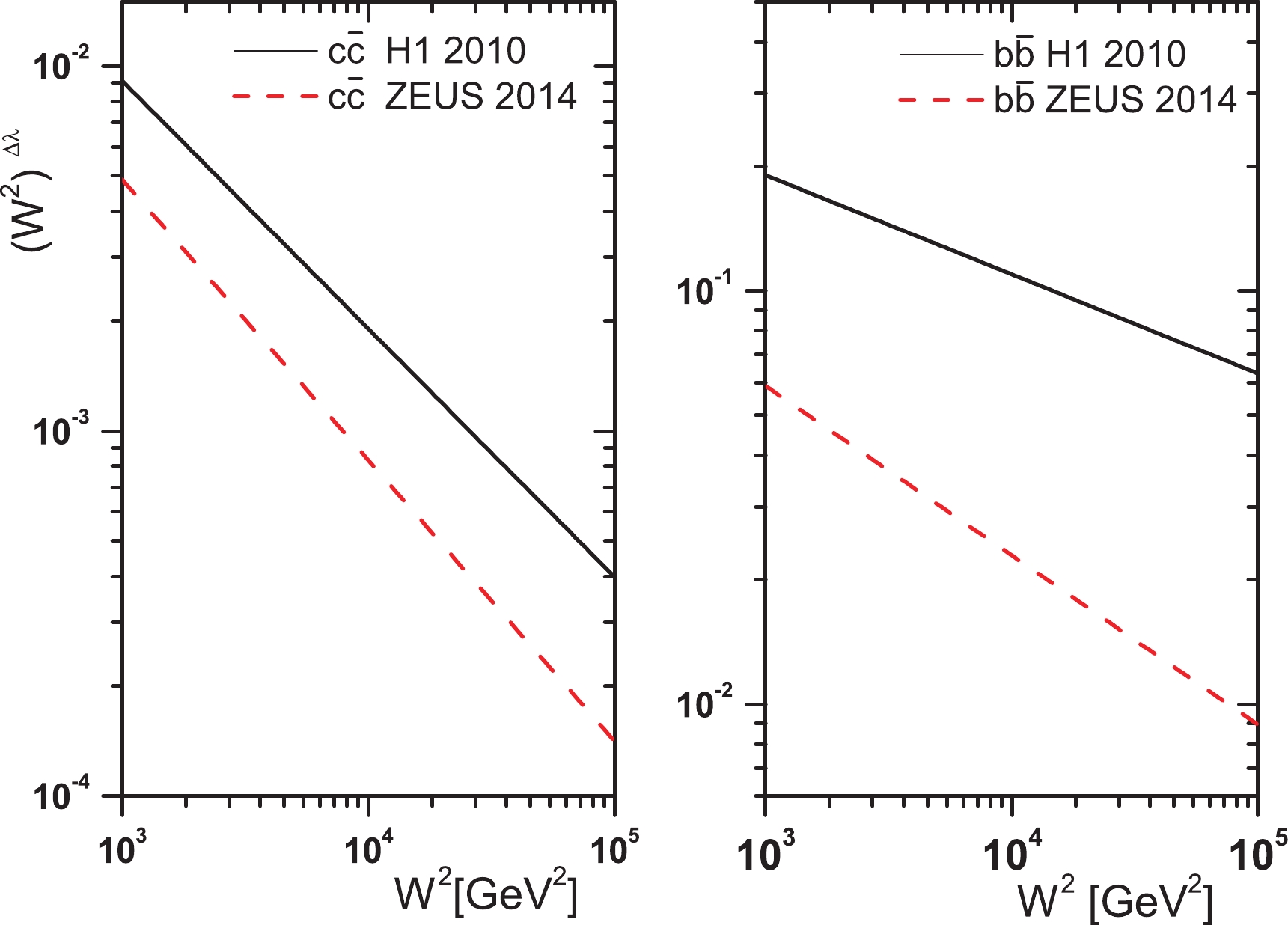 Figure3. (color online) Behavior of function
Figure3. (color online) Behavior of function 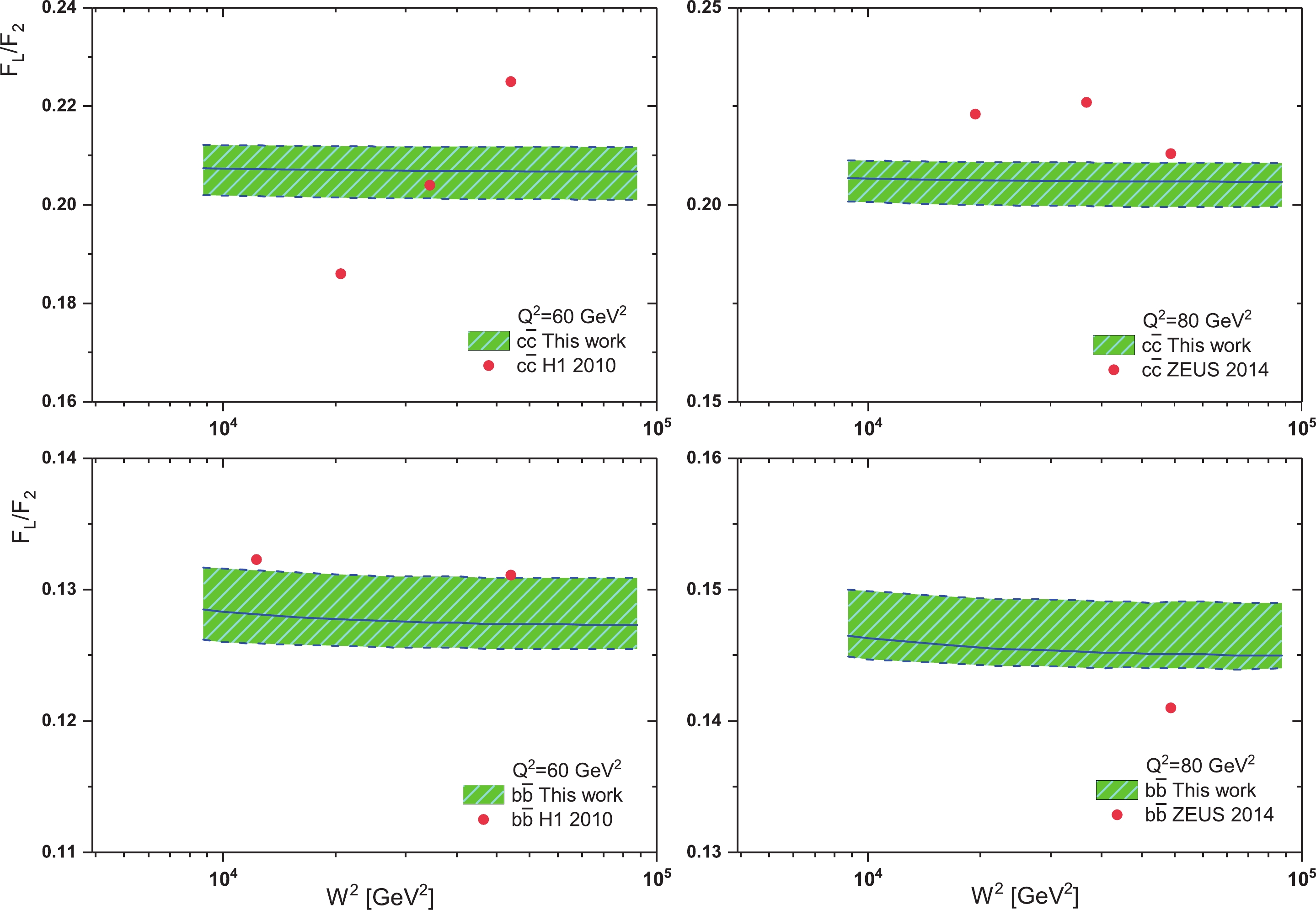 Figure4. (color online) Obtained
Figure4. (color online) Obtained | Quark | Mass | exp/fit | Model | Parameterization |
| c | 1.290 GeV |   |   |   |
| b | 4.049 GeV |   |   |   |
Table3.Heavy quark masses, with statistical and systematic uncertainties [3].
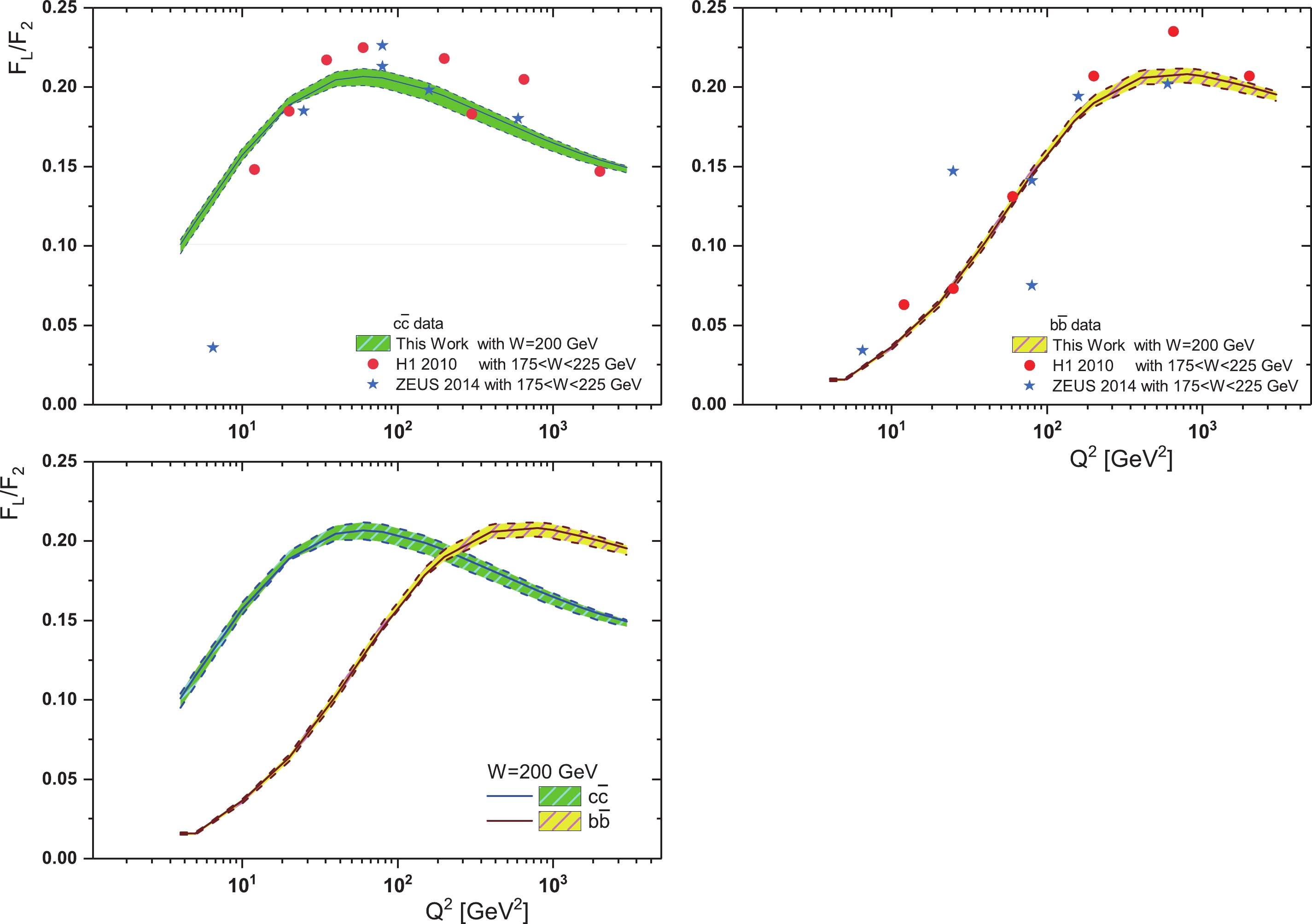 Figure5. (color online) The ratio
Figure5. (color online) The ratio Now we focus attention on the energy shift from HERA to the LHeC. LHeC data will also allow us to increase our knowledge of heavy flavour structure functions [94, 95]. Due to the increase in center-of-mass energy in new colliders, the LHeC will provide data on charm and beauty structure functions extending over nearly 5 and 6 orders of magnitude in
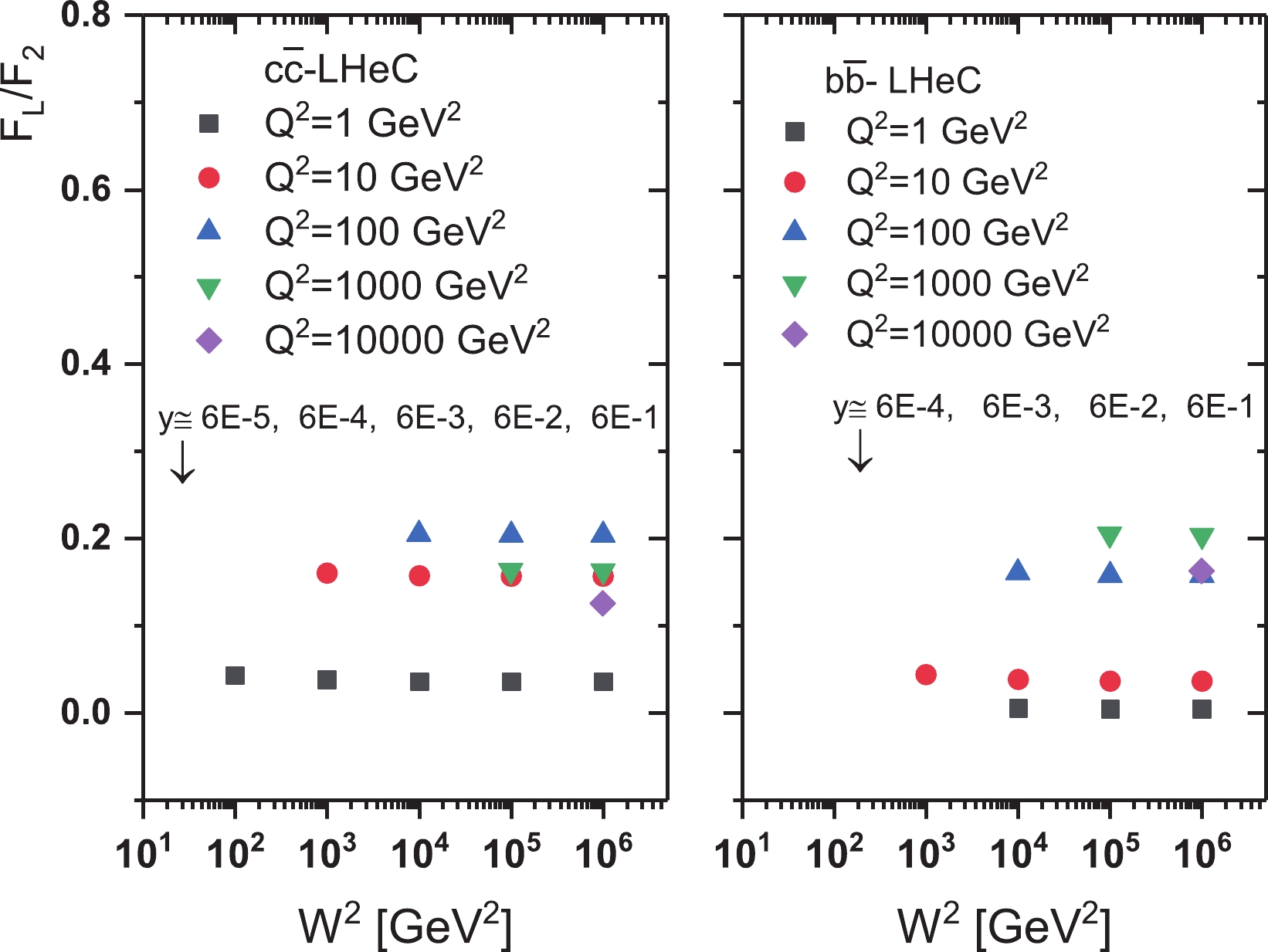 Figure6. (color online) Theoretical predictions for the ratio of (left) charm and (right) beauty structure functions at
Figure6. (color online) Theoretical predictions for the ratio of (left) charm and (right) beauty structure functions at 2
B.Top
Top quark pairs can be produced the LHeC and FCC-eh from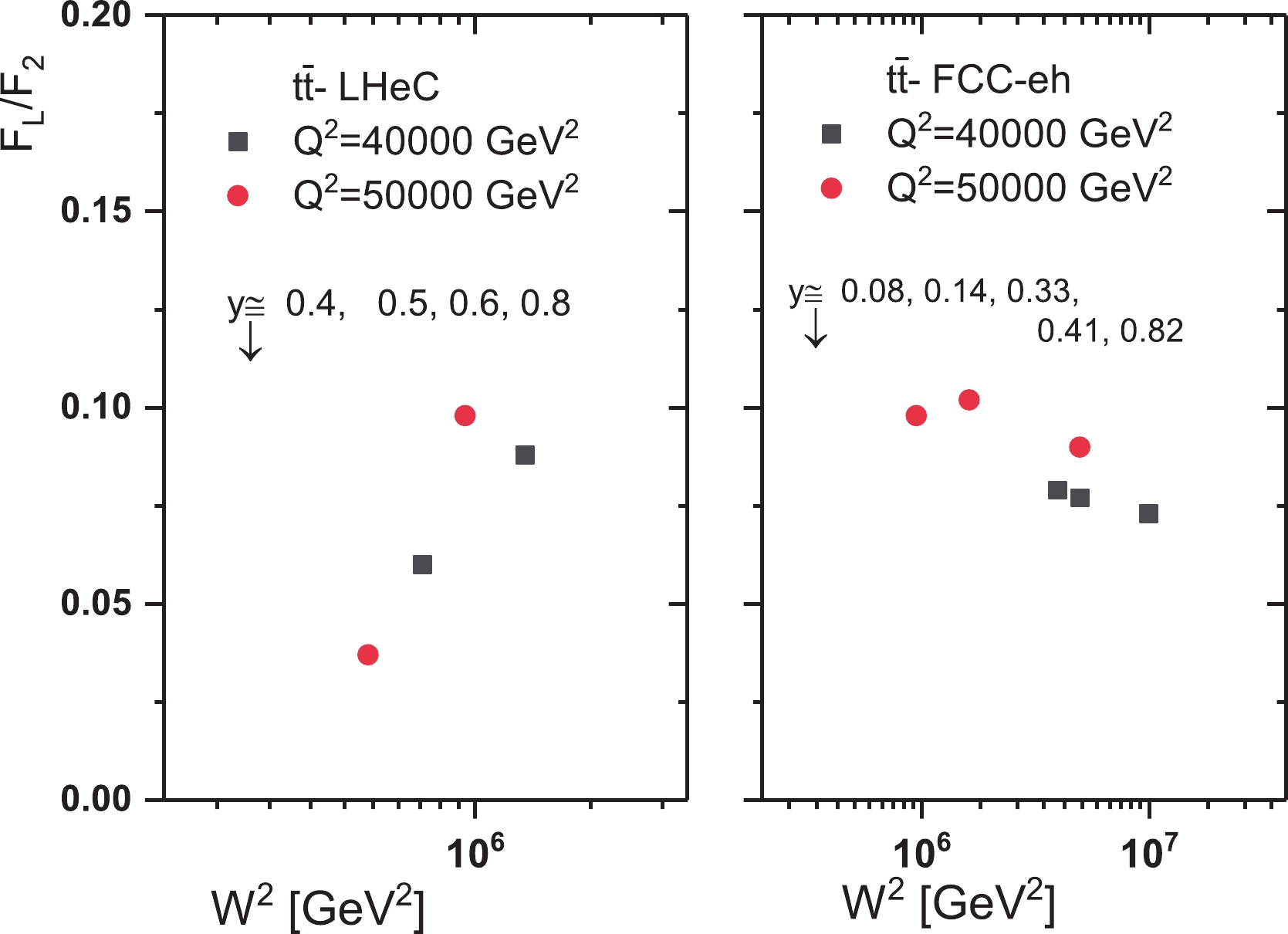 Figure7. (color online) Theoretical predictions for the ratio of top structure functions at
Figure7. (color online) Theoretical predictions for the ratio of top structure functions at 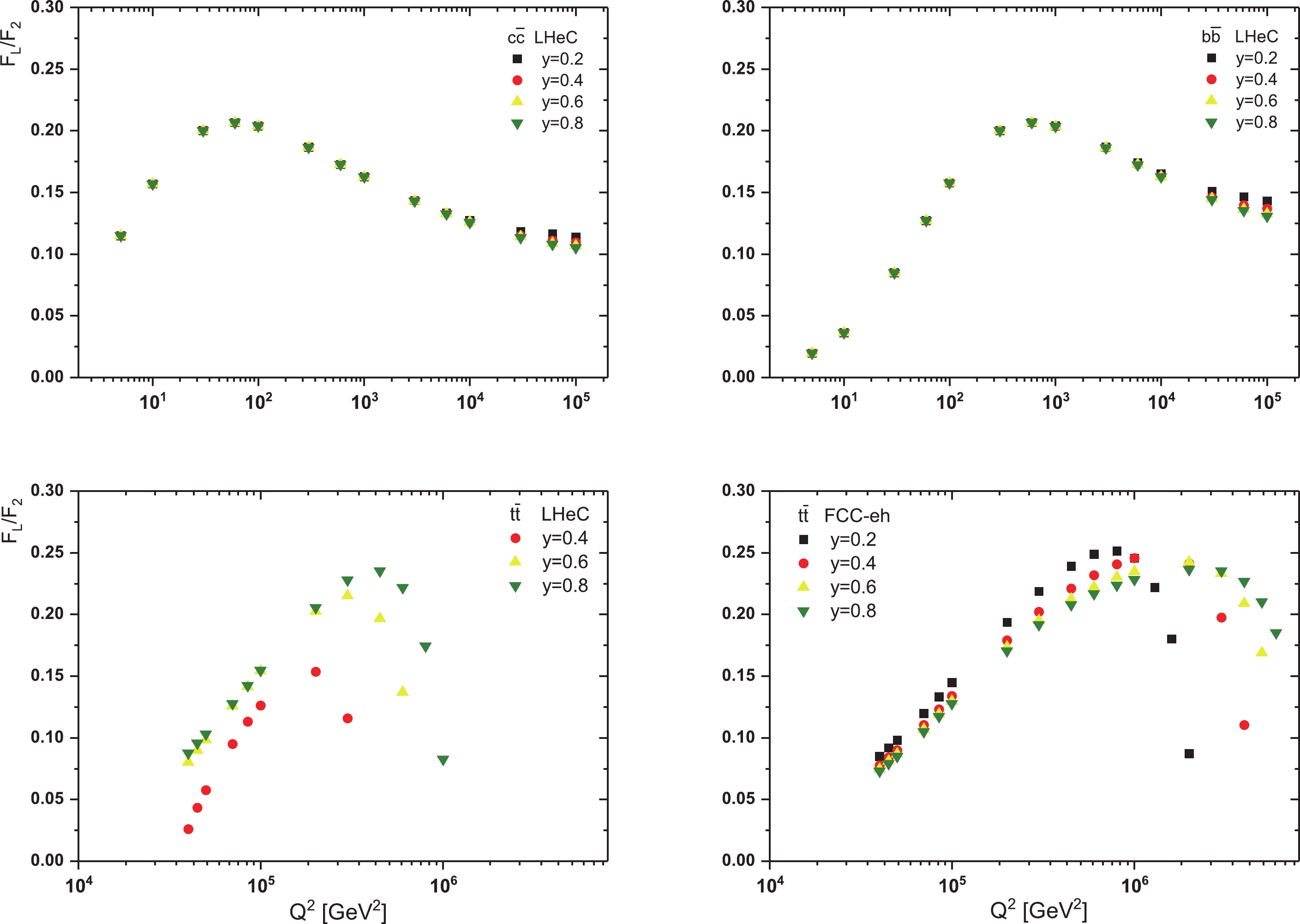 Figure8. (color online) Theoretical predictions for the ratio of charm and beauty structure functions at LHeC center-of-mass energy and also the ratio of top structure functions at LHeC and FCC-eh center-of-mass energies shown as a function of
Figure8. (color online) Theoretical predictions for the ratio of charm and beauty structure functions at LHeC center-of-mass energy and also the ratio of top structure functions at LHeC and FCC-eh center-of-mass energies shown as a function of For the calculations presented, we considered the mass error and the gluon exponent error. In all figures, bandwidth errors are included. In Fig. 9, we consider the effect of the renormalization/factorization scale uncertainty in the ratio
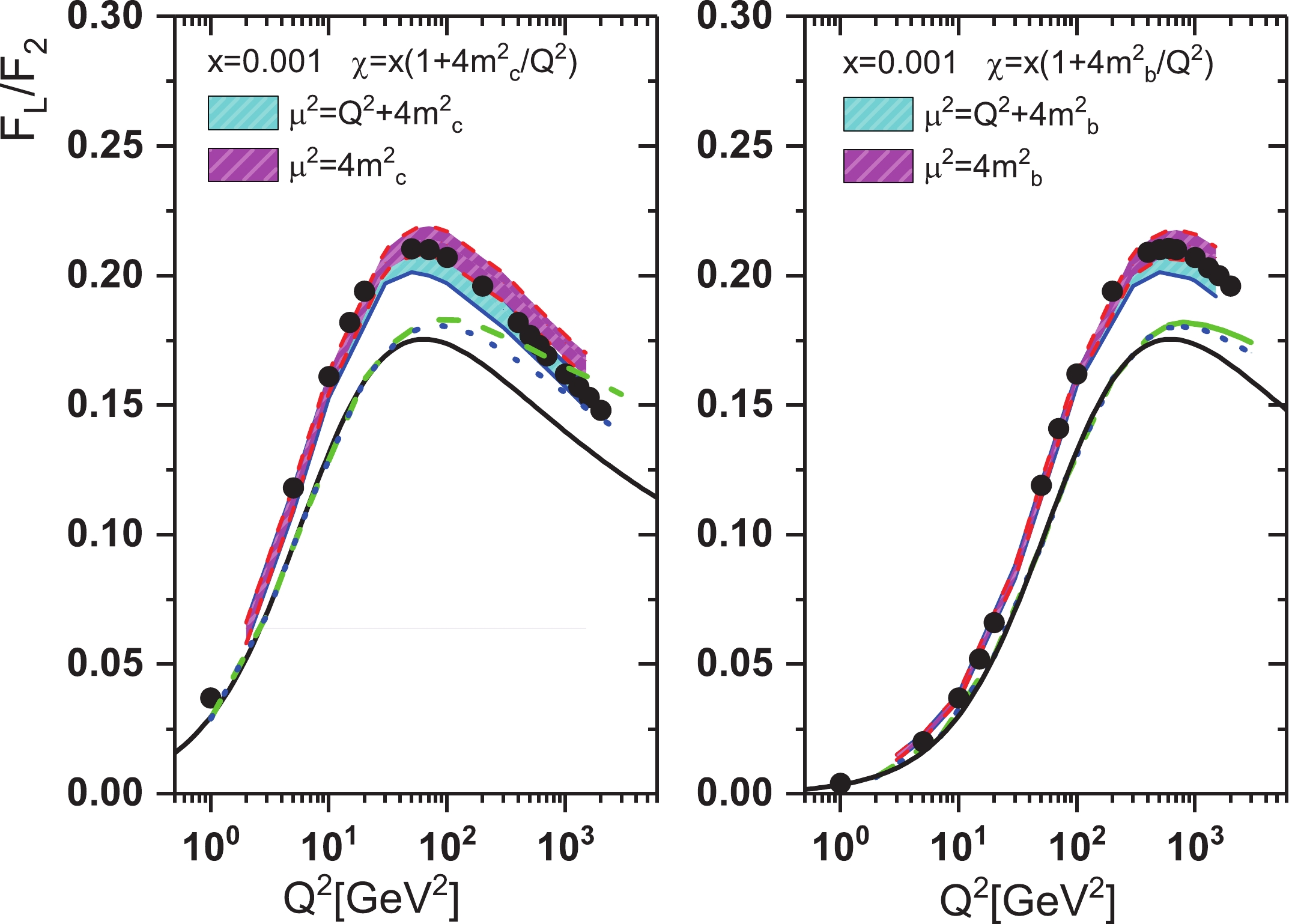 Figure9. (color online) Comparison of
Figure9. (color online) Comparison of 

